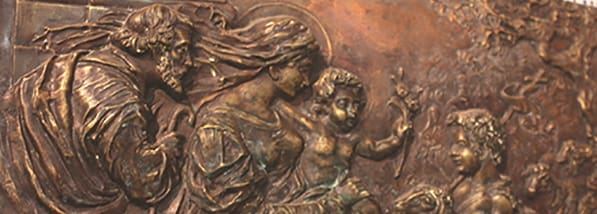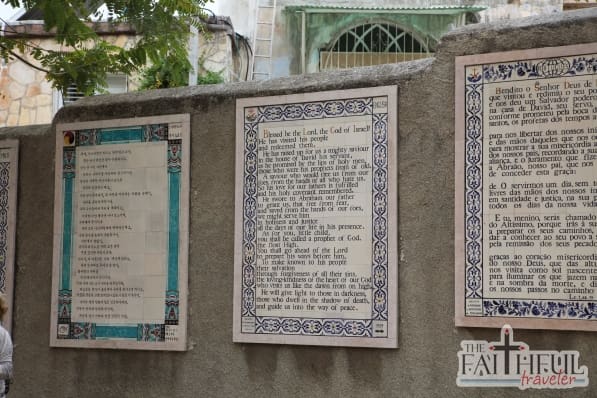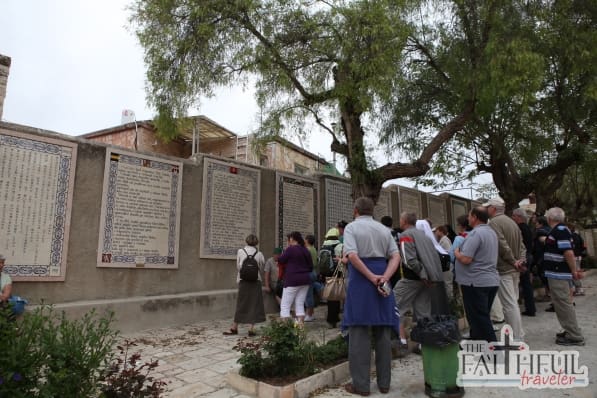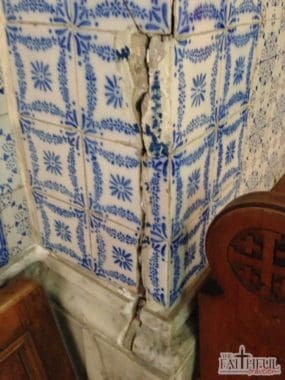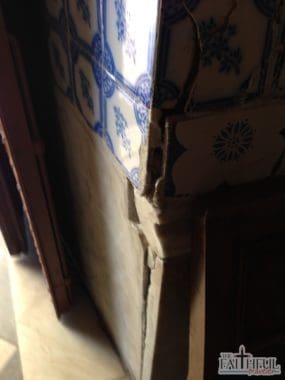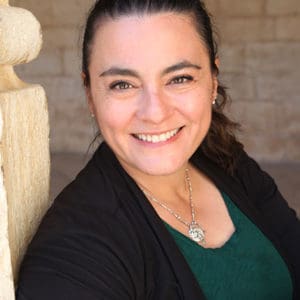Luke, Chapter 1 tells us the whole, exciting and miraculous story of the Birth of John the Baptist, which we celebrate today.
First, we read of the announcement–by an angel, no less–of the very unexpected conception and later birth of the baby who would grow up to become John the Baptist. His parents, Elizabeth and Zechariah, were older, you see, and had long given up hope of ever having a wee one of their own. But they were also righteous in the eyes of God, and He had a huge role for them and their little one in His plan for our salvation.
Then, that same angel visits the young virgin, Mary, at her home in Nazareth, about 90 miles north. The Annunciation takes place and Mary’s unselfish and generous yes changed the world. The angel also tells Mary that her relative, Elizabeth, is also with child, and this unselfish girl sets off: a two-day donkey ride for her (a 2 hour drive for us), to the hill country, today known as Ein Kerem.
There, Mary and Elizabeth meet, Mary sings God’s praises, John is born, and Zechariah follows suit with his own canticle.
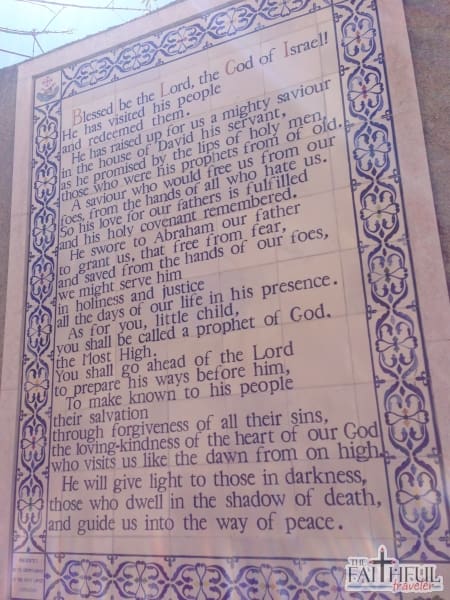
Those of us who have been to Ein Kerem–or who have seen our episode on it in The Faithful Traveler in the Holy Land (watch it here)–know that Ein Karem is, indeed, a hilly country. There is lots of climbing and many stairs.
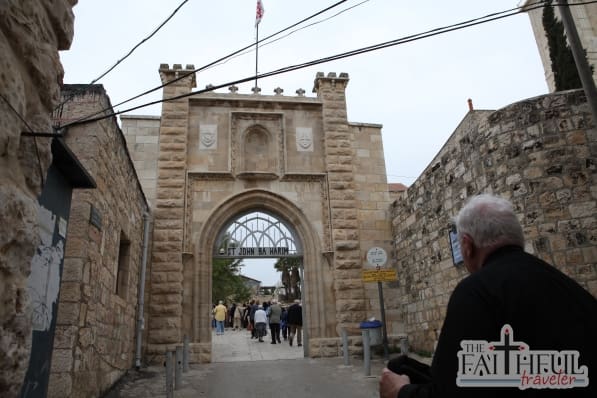
For pilgrims, Ein Kerem is known for two churches, the Church of the Visitation, built atop the home of Elizabeth and Zechariah, and the Church of John the Baptist, built atop the place of John’s birth, believed to be a second home of Elizabeth and Zechariah (you can see our photos from both sites here and here). Today, I’ll be telling you about the latter location.
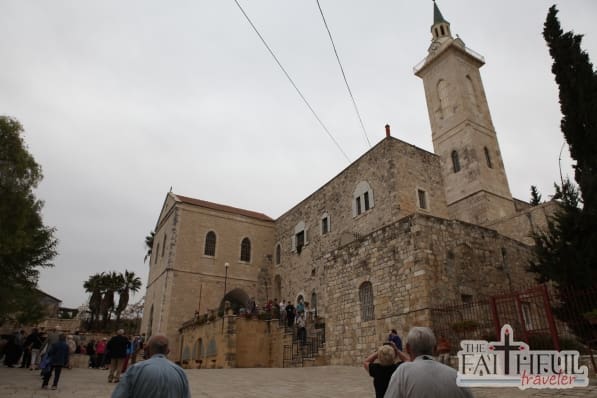
The Church of John the Baptist was designed by Antonio Barluzzi, nicknamed the Architect of the Holy Land because he designed so many of the beautiful churches that pilgrims encounter in that land. It was built in 1939 and, like many modern churches in the Holy Land, it was built over the ruins of a 12th century Crusader-era church.
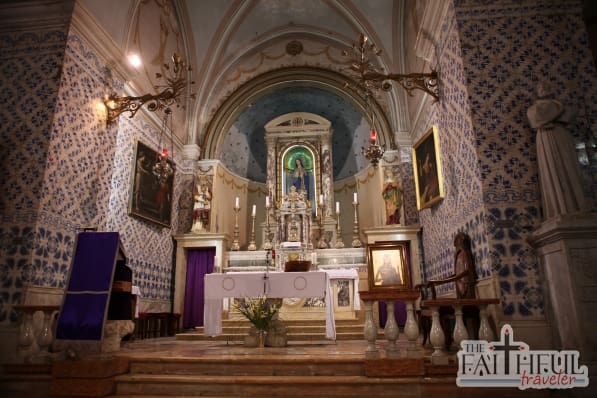
While the exterior of the church is somewhat unremarkable, inside you are greeted by a little bit of Spain! The entire church is lined in blue and white azulejos, the famous tiles loved by Spaniards. In fact, this church is under the patronage of the Spanish Royal family, which is why it is decorated this way. Also, much of the artwork on the walls is created by Spanish artists.
The church is built atop the cave believed to have been where John was born, called the Grotto of the Benedictus, named after the song of thanksgiving that Zechariah sang when his son was born. Atop the entrance to the steps that lead to the cave are the first few words from this canticle: “Blessed be the Lord, God of Israel, for He hath visited and redeemed His people.” Above that is a lovely painting of John baptizing Jesus.
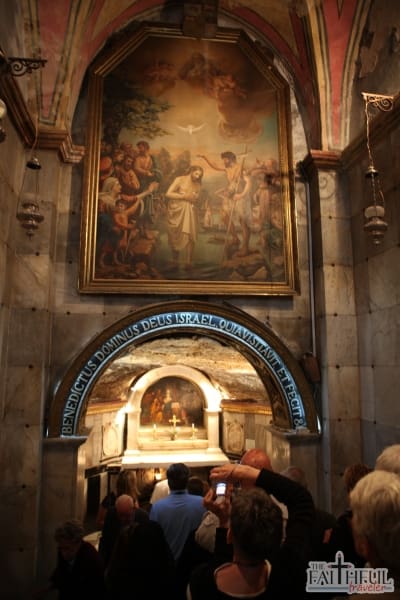
At the bottom of the steps, pilgrims encounter an altar with a disk below it. Written on it, in Latin, are the words “The precursor of God was born here.”
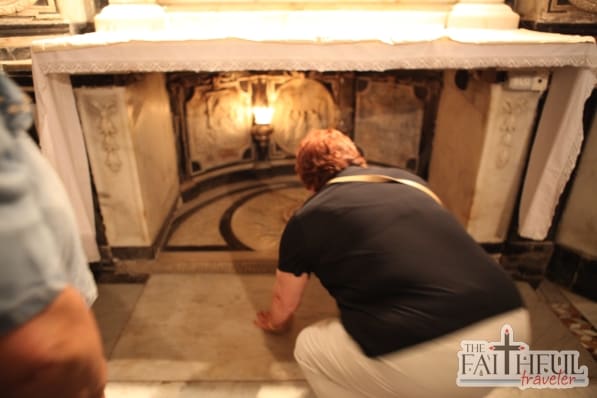
Outside, the walls are lined with tiles containing the words of the Canticle of Zechariah written on them in many different languages.
This is something I first saw in the Holy Land, but have since seen many times, and it’s a beautiful reminder of the universality of faith and the Church. God is God in all languages, and He is praised by all of us in whatever language we speak.
One of the sad things I learned about this church during a recent trip to the Holy Land is that it is in desperate need of reconstruction.
Cracks in the walls will soon make this beautiful church unsafe, and it may need to be rebuilt entirely.
Which puts me in mind of the impermanence of things of this world and how they affect our faith.
Visiting the Holy Land is an amazing experience–one that I think every Christian should do some day. It brings us closer to God and helps us better understand the sacrifices He made for us on Earth, and in that land in particular. Of course, the Holy Land today is not what it was when Jesus, his Mother, and his disciples inhabited it. With the exception of the Sea of Galilee and the Garden of Gethsemane, I think it can be safely said that nothing is as it was. Much time has elapsed and people have come and gone. Churches have been built and torn down and rebuilt over the sites held sacred for centuries.
But at the end of the day, our faith and the teachings of the Church stand firm.
This church may topple. It may be torn down and rebuilt. What is there in five years may be completely different.
Last week, another church in the Holy Land, the Church of the Multiplication of the Loaves and Fishes, was burned by vandals intent on making Christians feel unwelcome (read about it here and here).
It’s all very sad.
When all is said and done, as beautiful as they are, these are just buildings. Whether they are burned down or torn down, our faith should stand firm. Our faith is in God. Not in man, and certainly not in the buildings he erects.
May John the Baptist pray for us and for the people of the Holy Land, that there be peace in our hearts and homes.
(All photography courtesy and copyright of Diana von Glahn and The Faithful Traveler, LLC, all rights reserved, used with permission.)
By the way, if you’re curious about why I’m back and how David, my husband is doing, you can read about it here. Thank you for your prayers! They were answered!



